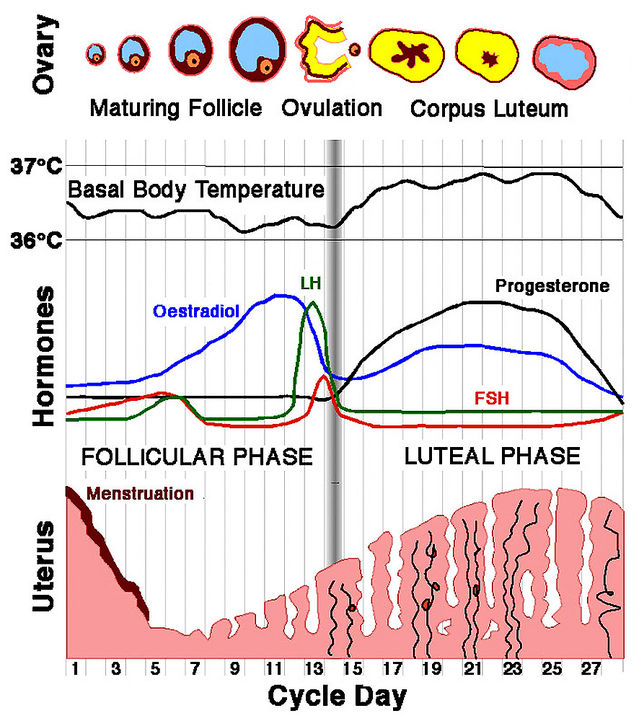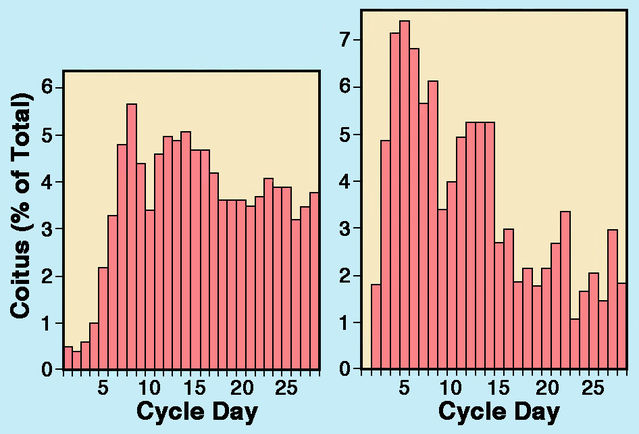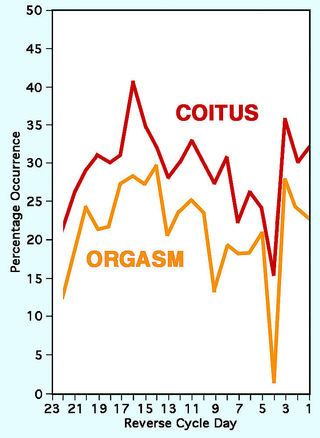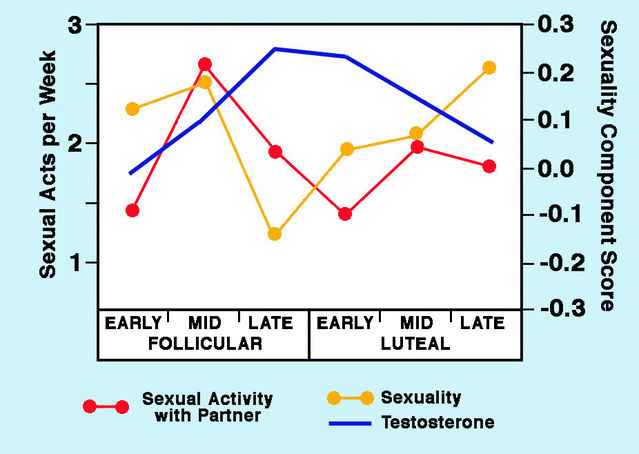Sex
Sex on a Cycle?
Tracking sexual desire and activity across the menstrual cycle.
Posted March 20, 2018

My previous blog post reviewed tests of Darwin’s suggestion that men’s beards are mate-attracting signals (Beauty and the Beard, posted February 14, 2018). One reader immediately asked whether women’s responses to beards change across the menstrual cycle. In fact, a paper published earlier this year by Barnaby Dixson and colleagues elegantly answers that question. But first of all we need to consider the basic expectation that sexual desire might vary across a woman’s cycle. The basic pattern of hormonal fluctuation across the cycle is well established: During the follicular phase after menstruation ends, oestrogens gradually rise to a peak just before ovulation, when one ovary releases an egg. Following ovulation, during the luteal phase, oestrogen levels fall and progesterone rapidly becomes the dominant hormone. A reasonable expectation is that these marked changes in hormone levels might influence a woman’s sexual motivation. But human ovulation is often described as “concealed”, because it is not externally evident and women themselves are generally not aware of it. How likely is it that hormonal changes would drive cyclical changes in women’s sexual desires and activities while leaving them blissfully ignorant of the timing of ovulation?

Early studies of sexual cycles
It is widely accepted that Katherine Bement Davis (1860-1935) conducted the first thorough investigation of women’s sexuality, based on information culled from anonymous questionnaires in the USA. Between 1924 and 1926, she published a series of papers on occurrence and frequency of sexual desire and coitus. Remarkably for the time, in addition to coitus within marriage, her survey included premarital and extramarital sexuality along with “auto-erotic practices” (masturbation), contraceptive use and homosexual experiences. Davis summarized her findings in her 1929 book Factors in the Sex Life of Twenty-two Hundred Women. One key finding was that about a quarter of women surveyed reported a distinct cyclical pattern in sexual desire. Strangely, however, pronounced peaks were identified before and after (but not during) menstruation, while very low levels prevailed around mid-cycle. This is diametrically opposite to the expectation based on the modern understanding of hormonal changes across the cycle, with ovulation halfway between two bouts of menstruation. Interestingly, women who reported periodicity in sexual motivation appeared to be significantly healthier but notably less happy.

The next major milestone concerning cyclical changes in sexual motivation and activity was a 1937 paper by Robert McCance and colleagues, who similarly used questionnaires to explore the relationship between hormones and psychology across the menstrual cycle. Unsurprisingly, this survey met with stiff opposition. Some medical school heads “took exception to forms on the grounds that sexual feeling was abnormal in unmarried women students” and would not permit circulation of the survey in their institutions. Undeterred, McCance and colleagues eventually managed to compile information from close to two hundred women—more than half of them unmarried—covering almost eight hundred complete cycles. Their graphs showing actual coital frequency differed markedly from the sexual motivation charts published by Katherine Davis. McCance and colleagues found no major peak prior to menstruation, but maximal frequency did occur on day eight of the cycle, in the middle of the follicular phase, and not around day fourteen, at the likely time of ovulation. As McCance and colleagues noted: “If ……… the human sperm can rarely live in the female generative tract for more than two days, it is difficult to see why seven days should elapse between the period of maximum desire in the female and her time of ovulation.”

Second wave studies
Another three decades passed before cyclical variation in women’s sexual desire was once again subjected to scientific study. Several publications by public health scientists Richard Udry and Naomi Morris are particularly notable. A graph in their widely cited 1968 Nature paper showed the distribution of coitus across the human cycle (counting backwards from the onset of the next menstruation). A clear peak was evident 16 days before the next menstruation, equivalent to day 12 in a 28-cycle. Because this primary peak is close to mid-cycle, it has generally been seen as confirming the expectation that coital activity should peak around ovulation. Perhaps for this reason, a second (only slightly lower) peak a few days before menstruation has passed largely unnoticed. Another crucial feature of the Udry/Morris graph that has also evoked little comment is that the frequency of female orgasm remains fairly constant at about 70 percent of coital acts across the entire cycle. It might be thought that orgasm should be relatively more common around the time of ovulation, especially if, as some have suggested, it increases the likelihood of conception.

In a 1971 paper, noting that daily records are the only acceptable basis for determining coital frequency, William James re-analyzed new information together with the data compiled by McCance and colleagues and by Udry and Morris. He confirmed that the highest rates of coitus occur immediately after the end of menstruation, while the lowest are found just before menstruation recurs. He concluded that It is unclear whether a minor peak is present around ovulation time, “but such a correlation, if it exists, is certainly not very powerful”. James also suggested that higher coital frequency just after menstruation could be mainly due to prior abstinence and a post-menstrual feeling of release. Overall, a predominant influence by the male partner could explain why coital rates are largely independent of ovulation time.
Psychiatrists Diana Sanders and John Bancroft effectively reviewed the relationship between female sexuality and the menstrual cycle in a particularly comprehensive 1982 paper. Crucially, in tandem with careful assessment of mood and sexuality from daily diaries, they identified cycle phases unequivocally by monitoring hormones in blood samples collected approximately three times a week from over fifty women. Sexual activity with the partner followed a cyclical pattern, with a significant peak in the middle of the follicular phase (days 6-10). A composite measure of sexual feelings revealed a similar peak in the middle of the follicular phase, but a second peak was also evident before menstruation, during the late luteal phase. This resembles the pattern originally reported by Davis. Some women provided information on initiation of sexual activity. Whereas initiation by the woman or mutually by both partners peaked in the middle of the follicular phase, initiation by the male partner tended to be more prevalent during the luteal phase. There was no indication of a mid-cycle peak around the time of ovulation for any aspect studied.

So where does this leave us?
Studies of the relationship between sexual desire, coitus and menstrual cycles in women have yielded variable results. This is only to be expected, as multiple confounding factors are involved, including initiation of sexual activity by one or other partner, a rebound effect following abstinence during menstruation, and use of oral contraceptives. Some studies have reported a peak in sexual motivation and/or actual coitus approximately coinciding with mid-cycle and hence with the likelihood of ovulation. But most studies have failed to identify a clear mid-cycle peak. The underlying assumption has been that hormonal changes over the cycle may influence sexual motivation. However, most studies did not include hormonal monitoring, so ovulation time has often been only approximately inferred. Overall, it is possible to recognize a general trend across many studies in which female sexual motivation shows a peak in the week following cessation of menstruation (days 8-14). In addition, a secondary peak often occurs during the week preceding the next menstruation (days 22-28 in a four-week cycle).
So now we can return to that reader’s question regarding possible variation in women’s preference for beards across the menstrual cycle. Women might be expected to show increased interest in men’s beards at mid-cycle, near the time of ovulation. A study by Barnaby Dixson and colleagues reported in 2018 specifically addressed this issue by examining test results for fifty-two women choosing between clean-shaven and bearded male faces, relative to hormonal evidence of cycle phase (follicular, periovulatory or luteal). Overall, women preferred bearded over clean-shaven faces in all phases of the cycle. But preferences for facial hair did not differ significantly between cycle phases and showed no significant association with reproductive hormone levels. Given the general lack of association between sexual motivation and menstrual cycle phase that has emerged from the above review, this is hardly surprising!
References
Davis, K.B. (1926) Periodicity of sex desire: Part I. Unmarried women, college graduates. American Journal of Obstetrics & Gynecology 12:824-838.
Davis, K.B. (1927) Periodicity of sex desire: Part II. Married women. American Journal of Obstetrics & Gynecology 14:345-360.
Davis, K.B. (1929) Factors in the Sex Life of Twenty-two Hundred Women. New York & London: Harper.
Dixson, B.J.W., Lee, A.J., Blake, K.R., Jasienska, O. & Marcinkowska, U.M. (2018) Women's preferences for men's beards show no relation to their ovarian cycle phase and sex hormone levels. Hormones & Behavior 97:137-144.
James, W.H. (1971) The distribution of coitus within the human inter-menstruum. Journal of Biosocial Science 3:159-171.
McCance, R.A., Luff, M.C. & Widdowson, E.E. (1937) Physical and emotional periodicity in women. Journal of Hygiene 37:571-611.
Sanders, D. & Bancroft, J. (1982) Hormones and the sexuality of women — The menstrual cycle. Clinical & Endocrinological Metabolism 11:639-659.
Udry, J.R. & Morris, N.M. (1968) Distribution of coitus in the menstrual cycle. Nature 220:593-596.


